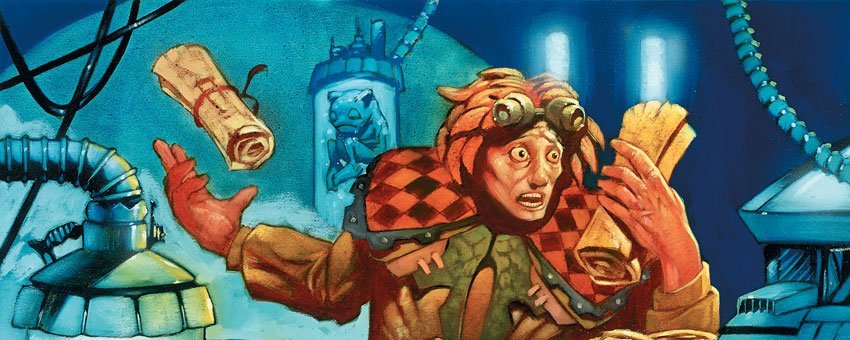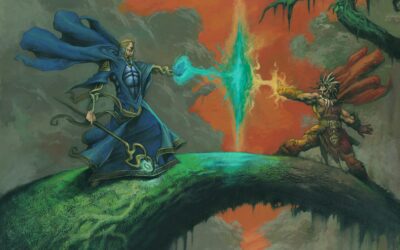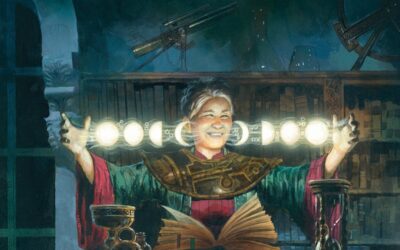We folks at Pauperwave (AdeptoTerra and Crila Peoty) thought about writing an article inspired by Paulo Vitor Damo Da Rosa’s masterpiece series on the least and most difficult decks to play in Standard, Modern and Legacy. The obvious twist here is that we are applying the concept to our beloved format, Pauper.
In doing so, we decided to leave some archetypes out because we deemed them to be too linear play-wise (e.g. Aura Hexproof) or to be hardly relevant/popular (e.g. WB Pestilence).
As far as collecting data, we didn’t base our decision on community/players votes. Nonetheless, we hope that the article can be enjoyable for readers and spark a conversation on the topic.
Score criteria
Defining how hard it is to play a certain deck can surely be tricky. Because of this, we decided to use a scoring system built on the criteria that follow. Evaluations are, obviously, based on our opinions.
- “Non-linearity”- max. 1 point
A “non-linear” deck is defined as one with a flexible gameplan and playstyle, able to change its plans according to the texture of the game, board position, match-up faced, etc. The higher the score, the more said deck is considered to be non-linear. - Speed- max 0.5 pt
Is the deck “time-hungry” – i.e., does it take long to get its plan going? The higher the score, the more time is thought to be required to do so. - Amount of in-game choices- max. 1.5 pts
Are there several or little choices to be made in a single turn with this deck? The higher the score, the higher is the perceived number of decisions one can make when playing said deck. - “Punishability”- max. 1.5 pt
To which extent does making wrong choices affect the outcome of a game with the deck? The higher the score, the more dramatically wrong choices are perceived to negatively impact the chances of victory.
#9 Rakdos Monarch / Mono Black Control 1.0
We decided to lump the two archetypes together because they have a similar gameplan. That said, Rakdos is more oriented towards hand disruption and card advantage, whereas MBC is more focused on overloading on removal plus Drain Life effects.
AdeptoTerra 1.0
Non-linearity: 0.5
Speed: 0.5
Amount of in-game choices: 0
Punishability: 0
Rakdos Monarch and MBC are archetypes that are undoubtedly based on heavy disruption/hate against any opponent (hand disruption and graveyard hate against control, removal-based disruption against aggro). Rakdos is the one with more options. Despites this, I don’t believe there are many of decisions to be taken besides those posed by Duress and Faithless Looting.
I do not consider these decks to be that punitive because cards such as Thorn of the Black Rose and Gray Merchant of Asphodel are an unresonable payoff
Crila Peoty 1.0
Non-linearity: 0
Speed: 0,5
Amount of in-game choices: 0,5
Punishability: 0
A midrange deck designed to be the evolution of Mono-Black in a metagame where UB Angler is a popular deck. In my opinion, the only difficulties in piloting these decks are:
- managing removal spells, i.e. knowing when to use one and not the other. This can turn out to be decisive in several spots, especially when dealing with Battle Screech is hard;
- knowing when to estabilish the Monarch, when to “risk it” and how to play it with double removal backup. The black queen is our win condition, which means it’s very important that she gets deployed with perfect timing.
#9 Affinity 1.0
AdeptoTerra 1.0
Non-linearity: 0
Speed: 0
Amount of in-game choices: 1.0
Punishability: 0
Choices are mostly geared towards post-sideboard games– what to cut, what to sideboard in and, above all, how to play. The development of the early turns is pretty much linear all the time; so is the aggressive posture taken during matches. To me, the difference really lies in picking the right sideboard cards and understanding in advance which are the decks that we mainly want to attack/defend from.
Crila Peoty 1.0
Non-linearity: 0.5
Speed: 0
Amount of in-game choices: 0.5
Punishability: 0
A true “mad horse” of all sorts. Although Affinity is widely deemed to be a “brainless deck” – much like RDW, to name one-, I don’t agree. There are certain small in-game choices, such are:
- Executing a beatdown plan by aggressively cracking Chromatic Stars to filter colors for our creatures or biding time by saving the rocks and developing the game towards the Atog–Fling plan instead;
- going all-in right from the very start by deploying multiple fatties or prioritizing mana fixing and waiting the following turn to drop said creatures;
- knowing whether to use a Hydroblast to counter a burn spell on a creature or whether to save it for possible Gorilla Shamans down the line. This might also imply hoping to chain-draw multiple fatties or getting to Reaping the Graves.
As highlighted, I do believe that a bit of thought is always required. Let’s all give the “real” Affinity deck its dignity back!
#8 Burn 1.25
AdeptoTerra 1.0
Non-linearity: 0.5
Speed: 0
Amount of in-game choices: 0.5
Punishability: 0
Burn is not as linear as one might expect. In certain matchups, the right move might be to throw burn spells at creatures and not at the opponent’s face- do we really want to leave Ninja of the Deep Hours or Wellwisher alive?
Crila Peoty 1.5
Non-linearity: 0.5
Speed: 0
Amount of in-game choices: 0.5
Punishability: 0.5
Pauper Burn isn’t as linear as one might expect it to be, especially if compared to its Modern counterpart. Knowing whether and when to play Thermo-Alchemist or Curse of the Pierced Heart, how to setup a full Searing Blaze, when it’s convenient to play around Spellstutter Spirite and when to go for broke by unleashing a flurry of burn spells in a single turn to overload opposing counterspells… All of these are, to me, determining factors – albeit simple ones – in deciding the outcome of games. Once again, my advice is to test the deck before labeling it as brainless.
I also gave half a point to the linearity criteria because the deck can sometimes throw its spells at creatures and not at face. In matchups like Monoblue Delver and Elves, having steady sources of damage like Thermo-Alchemist (and possibly Ghitu Lavarunner/ Curse of the Pierced Heart) allows to point burn spells at creatures and to go for a slow kill.
Although this B-plan might sound stupid, it often turns out to be the right one to execute in order to win. Knowing when to steer from the conventional gameplan sets great Burn players apart from average ones.
#8 Boros Bully 1.25
AdeptoTerra 1.0
Non-linearity: 0
Speed: 0
Amount of in-game choices: 0
Punishability: 1.0
Boros Bully is much easier than Boros Monarch to play and is also much more board-oriented. Conversely, I think it’s less forgiving due to being more susceptible to sweepers and not having 8 burn spells to steal the game.
Crila Peoty 1.5
Non-linearity: 0.5
Speed: 0
Amount of in-game choices 0.5
Punishability: 0.5
Unlike its brethren, no “rock into rock” here: what lies in front of us is a true midrange deck disguised as aggro. It is able to apply more pressure mid-game and to flood the board with small creatures, making it very hard to steal the Monarch from it.
The deck supports a double plan: protecting the Monarch and swarm beatdown. Both of them are made possible by Prismatic Strands. In my opinion, the only true relevant choices are the following:
- being able to optimize the king of red cantrips, aka Faithless Looting;
- properly managing the timing of Palace Sentinels;
- knowing when/whether to go aggressive or to play defensively.
#7 Stompy 1.5
AdeptoTerra 1.5
Non-linearity: 0
Speed: 0
Amount of in-game choices: 0
Punishability: 1.5
Stompy doesn’t pack a great deal of choices, as they are mostly about managing combat damage properly (although it is a fundamental skill with the deck).
The deck is unforgiving due to the constant need of playing against potential removal, which Pauper is ripe with. Post-board games require to understand what is worthy of being addressed, especially against other aggressive strategies. Being an aggro deck that is meant to be played on-curve, another weak point lies in not being able to infuence what’s on the top of the deck.
Crila Peoty 1.5
Non-linearity: 0
Speed: 0
Amount of in-game choices: 0.5
Punishability: 1
Unlike other aggro decks like RDW and Slivers, Stompy is equipped with a greater amount of choices, but also with a certain degree of unforgiveness.
Playing it made me understand – and pleasantly so – that there are several non-trivial choices to operate. Knowing when to play a certain creature over another, when to play Rancor or Elephant Guide, when to keep mana up for Vines of Vastwood, when to attack at the cost of losing creatures or when to wait one more turn…each of these can snowball the outcome of games, for better or worse.
Some might question such a high ranking for a deck that’s considered to be quite linear. I admit I might have some bias, as I don’t usually play aggro decks. However, I recommend the naysayers to pick Stompy up– surprises may arise.
#6 Elves 1.75
AdeptoTerra 2.0
Non-linearity: 0.5
Speed: 0
Amount of in-game choices: 0
Punishability: 1.5
Even though there might be scenarios where we need to evaluate which card to play first – an Elvish Vanguard, a Lys Alana Huntmaster or another spell-, most of our gameplan revolves around dropping creatures on the board altogether as soon as possible. In doing so, we attempt to overload the opponent’s disruption. Viridian Longbow is the card with the highest potential choices-wise, at least in game one, as it allows to interact against other strategies. That said, the card alone isn’t really unpredictable, nor sees much play.
Elves isn’t known for too many choices, but the ones it poses are mostly about circumnavigating opposing hate. It is, however, very unforgiving: all the creatures – especially in the early turns – are crucial, considering the very low landcount of the deck (13). To me, the most fascinating part about this deck lies in understanding how to overcome disruption – when possible, of course.
Crila Peoty 1.5
Non-linearity: 0.5
Speed: 0
Amount of in-game choices: 0.5
Punishability: 0.5
Elves is a truly unique deck in the format. Despites not being particularly challenging to play, I have noticed that many have this tendency to pilot it too passively, never attacking and waiting to have an active Timberwatch Elf or Wellwisher to finally start going to town.
To me, the true skill with the deck lies in understanding when to switch gears and go aggro – even in the face of unfavorable blocks. Playing UR Delver, I’ve seen one too many games lost by Elves opponents due to them giving me (many) additional turns to dig for other Augur of Bolas, Counterspells or decisive Swirling Sandstorms.
Post-sideboard, it is imperative to play around opposing hate when possible (Electrickery comes to mind before anything else) and to correctly figure out whether overextending is the right thing to do according to the game’s texture and board position. It is equally interesting to manage the delicate balance of side-ins and side-outs, as over-sideboarding is likely to weaken Lead the Stampede.
#6 Boros Monarch 1.75
AdeptoTerra 2.5
Non-linearity: 0.5
Speed: 0.5
Amount of in-game decisions: 0.5
Punishability: 1.0
This archetype would be one of the easiest in the format, if not for the fact that some trivial mistakes can cost games. In attrition match-ups, Boros Monarch is capable of accrueing more card advantage than many of our opponents. Additionally, lots of players tend to focus on attacking Prophetic Prisms and Alchemist’s Vials. With this in mind, managing resources correctly is the key to pilot the deck. Bouncing a land with Glint Hawk and Kor Skyfisher, for instance, is often the wrong play. It is important to understand which situations require a more aggressive stance and which are better managed by staying on defense.
As for Palace Sentinels– once again-, understanding how to time it properly is a must, but also that it’s often correct to side it out against aggressive strategies.
Crila Peoty 1.0
Non-linearity: 0
Speed: 0.5
Amount of in-game choices: 0.5
Punishability: 0
Once the noble art of going “rock into more rocks” has been learned – I am refering to bouncing the cantripping artifacts for value, of course -, most games are played in a defensive “midrangey” way, which becomes even more defensive when the Crown is on our side.
The difficulties posed by the deck are mainly two:
- Timing Palace Sentinels correctly – especially if our opponent is also playing Monarch cards;
- The speed with which we play: the deck requires a lot of small, incremental plays – many of which quite trivial -, demanding a steady pace.
#5 Murasa Tron 2.0
AdeptoTerra 1.5
Non-linearity: 0
Speed: 0.5
Amount of in-game choices: 1.0
Punishability: 0
Murasa Tron is, in my opinion, a linear deck. In comparison to the Dinrova version, it is more suited to a Draw-Go style, with no possibility of shifting from such stance to a lock plan due to the lack of Dinrova Horror. Capsize is, for all matters, much slower, as it requires double the amount of mana. The Horror, on the other hand, allows for a more “interactive” approach (e.g. bouncing Boros Garrison to prevent Palace Sentinels from landing), given that the 4/4 body is definitely relevant.
Besides this, the fact that Murasa Tron is slower in assembling the trio of Urza lands makes it so that casting Mulldrifters and Mnemonic Walls isn’t always possible during the early turns.
As for punishability, much as I do for Dinrova version, I don’t consider Murasa Tron to be particularly punishing: Rolling Thunder and Ulamog’s Crusher allow to undo many less-than-optimal choices (or even straight mistakes, sometimes).
Crila Peoty 2.5
Non-linearity: 0
Speed: 0.5
Amount of in-game choices: 0.5
Punishability: 1.5
Due to the lack of late-game insurance in the form of Dinrova Horror, messing up any kind of decision in the early game can easily turn out to be game-losing. Managing resources tightly is a must.This means understanding when and what to throw our removal spells at and, in general, being able to “play fair” until the magic Tron trio propels us to inevitable victory.

#5 UB Alchemy 2.0
AdeptoTerra 2.0
Non-linearity: 0
Speed: 0.5
Amount of in-game choices: 0.5
Punishability: 1.0
A classic attrition gameplan, culminating in Mulldrifters and Gurmag Anglers at the end of the curve. Many games are won by depleting the opponent’s resources via copious disruption, followed by Angler beatdown.
The Alchemy deck is unforgiving due to its clunky mana curve. Additionally, unlike Tron, the deck lacks mana-cheating cards, which results in weaker recursion engines and late-game bombs.
Crila Peoty 2.0
Non-linearity: 0.5
Speed: 0.5
Amount of in-game choices: 0.5
Punishability: 0.5
What we have here is a classic blue-black control deck that can sometimes afford to change its gameplan mid-game and to go aggressive with Gurmag Angler. The presence of cantrips allows for a certain number of choices and a certain degree of punishability. Still, the level of difficulty implied is, in my opinion, inferior to the one of Delver decks.
I do believe, in fact, that control decks are often overrated when it comes to the perceived skill required to play them. Once control has been estabilished, the plan is always the same: dragging the game to the very late stages while surviving – a thing that’s tipically easy to accomplish from a certain point onwards.
To me, “difficulty” in playing a certain deck doesn’t lie in the number of global choices made throughout a game if their alternatives are trivial. True difficulty, rather, lies in having one or more of such alternative choices that are not trivial. If a game requires to make 100 choices, but only 20 of these have true non-trivial alternatives and just 5 are very unforgiving, my opinion is that such game can’t be considered to be more “difficult” than another one presenting 15 non-trivial choices and 10 that are highly unforgiving. In other words: the amount of choices doesn’t really matter if they are, in most cases, trivial.
#4 Mono-blue Delver 2.25
AdeptoTerra 1.5
Non-linearity: 0
Speed: 0
Amount of in-game choices: 0
Punishability: 1.5
The current incarnation of the mono-colored Delver deck is much more aggressive than what it used to be. While the Esper Familiar-era build was more akin to a proper “aggro-control” concoction, we could call the modern day-version a Fish deck, as it is more geared towards estabilishing an early Delver of Secrets and/or Ninja of the Deep Hours while preventing too many blockers and removal spells from joining the fray. The deck is quite nimble in its setup and doesn’t pack shuffle effects or play-patterns that are clunky. In terms of playskill, the deck is easy to pick up for those who already know how to pilot Delver flavors and, more broadly, cantrip-based decks.
At the same time, though, the number of choices is limited and it isn’t always possible to switch gears plan-wise. The restricted range of answers Delver has access to – counterspells and bounce spells – makes it so that racing in the air is its only true strategy.
For such reasons, I’d say that the deck is highly unforgiving, and even more so against decks that have all its angles covered, such as Boros Monarch. If the deck lets problematic spells slip through its cracks – regardless of whether it’s due to mistake or lack of countermeasures -, the setback taken can be severely crippling.
Crila Peoty 3.0
Non-linearity: 0.5
Speed: 0
Amount of in-game choices: 1
Punishability: 1.5
Unlike its two-colored child, the old King of the format is much more tempo-based, courtesy of a flawless manabase. The deck is highly unforgiving nonetheless – mostly because it is incapable of getting rid of opposing permanents if not by bouncing them or by racing back.
Mono-blue Delver is, indeed, incapable of behaving in a proper midrange fashion. Most of the times, threats must be simply countered on their way down. At the same time, it can’t sit playing the waiting game forever: doing so would likely make it succumb to better late-game decks, such as Tron, Boros and UR Delver. The deck lives on a thin line, shifting between favorable and unfavorable positions in a precarious balance.
#4 Dinrova Tron 2.25
AdeptoTerra 2.5
Non-linearity: 1
Speed: 0.5
Amount of in-game choices: 1.0
Punishability: 0
Dinrova Tron isn’t a linear deck. I could go deeper into this topic, as the linearity of the deck decreases with the increase in the quality and quantity of answers played. However, let’s say that DT has the tools to adapt the way it play games according to the situation and the match-up faced (cards like Moment’s Peace and Rolling Thunder, for example, can change the pace of games).
Dinrova Tron requires a good amount of time to setup if we don’t pack a quick win condition, we can’t find it or we are not able to set it up. This especially relates to paper play, as playing slowly with real cards is more likely to get you to the extra turns and to a draw.
The deck packs a decent amount of choices in relation to the answers played, the solutions that card-drawing spells (Forbidden Alchemy, Sea Gate Oracle and friends) find and the match-up faced.
I don’t believe DT is unforgiving- not as much as other decks, at least. The pay-offs and card advantage provided are so strong that the deck can do well in less-than-expert hands. Don’t get me wrong: playing well is still a mandatory requirement. However – and this is especially true in control mirrors-, when tapping 3 lands allows you to play an evasive creature with two cards to boot, you can definitely rely on some wiggle room.
Crila Peoty 2.0
Non-linearity: 0
Speed: 0.5
Amount of in-game choices: 0.5
Punishability: 1
Dinrova Tron has always had one and only goal: getting to the late-game, where it reaches complete control. This is made possible by Pulse of Murasa, Ghostly Flicker loops and an unparallaled card advantage engine.
The deck packs a decent amount of choices. Still, it doesn’t always pose choices that are crucial within a single turn. Rather, DT must be played with a long-term mindset, thinking about future turns in advance by tutoring the right piece while optimizing its mana color- and quantity-wise. Piloting the deck also calls for good dexterity, so as not to get to extra turns. Closing the game in a timely manner without dragging things out is a very real requirement.
Playing around hate in post-board games can get difficult. Navigating through Relic of Progenitus and Pyroblast requires some thought, and one’ll need to come up with ways to get to the late stages by answering opposing threats while avoiding to deplete the deck’s resources.
#3 UR Delver 2.75
AdeptoTerra 3.0
Non-linearity: 1
Speed 0.5
Amount of in-game choices: 1.0
Punishability: 0.5
UR Delver isn’t a linear deck. It can often go to turns (or you can timeout) if you don’t know how to play it well due to the high number of plays and choices implied. This can range from which land to play for the turn to the way you sequence you cantrips.
I don’t deem it to be that punitive – unless, of course, one messes up key plays. The deck’s payoff are very good and the answers played cover a wide range of threats.
Crila Peoty 2.5
Non-linearity: 0.5
Speed: 0
Amount of in-game choices: 1.0
Punishability: 1.0
Out of the Delver family, “Winter Delver” is, in my opinion, the least difficult flavor to play. Unless an undisrupted early Delver goes the distance, most of times it is played as a midrange deck that can turn games upside down on the strength of multiple Spellstutter Sprites or Ninja of the Deep Hours.
Despites retaining a good number of choices – mostly thanks to its cantrips and counterspells-, this deck loses a good part of the “tempo part” that’s so engrained in the monoblue version. In light of this, the choices with the deck are slightly less punishing.
The skill with this deck lies in knowing how to manage the balance between burn spells and counters when cantripping and off Augur of Bolas. The most delicate stage of the game, in my opinion, lies in the early turns, when being able to correctly develop the mana is crucial. Once the deck hits 3 or 4 lands, Winter Delver becomes relatively easy to pilot.
#3 UB Delver 2.75
AdeptoTerra 2.0
Non-linearity: 0
Speed: 0
Amount of in-game choices: 1
Punishability: 1
UBxd might feel difficult to pilot. However, much like with monoblue Delver, coming to the deck with a pre-existing knowledge of how Delver decks operate is enough to have a grasp of it.
The amount of choices UBxd presents is relatively low, because we’ll usually play the deck with a more aggressive approach than other Delver flavors, which won’t always be as punishing thanks to the free spells and the notable pay-offs that the deck has access to.
Crila Peoty 3.5
Non-linearity: 0.5
Speed: 0
Amount of in-game choices: 1.5
Punishability: 1.5
The plan is the typical one pursued by tempo decks: plenty of disruption wrapped in a Xerox shell while riding a hard-to-answer threat to the finish line. Still, the difficulty posed by this deck is unique in Pauper.
The deck asks for an impressive number of choices in the very first turns, mostly on how to develop the manabase until the third, crucial land-drop, and on how to strike a balance between removal, counterspells, threats and cantrips.
Such complexity is equally tangible in the mid-game: free spells are plenty, and it’s not always easy to figure out the right time to Gush, when to use Foil and what to pitch to it, which cards to put back after a Brainstorm. Each choice is crucial and potentially very, very punishing.
#2 UW Tribe 3.25
AdeptoTerra 3.0
Non-linearity: 0
Speed: 0.5
Amont of in-game choices: 1
Punishability: 1.5
The archetype has a number of choices and decision trees that increase in proportion to the amount of answers it packs in its 75. The difficulty lies in figuring out when to go for the combo kill and how to plan the game. Its shell allows to exploit the tempo advantage provided by blue in an efficient way – especially by using cards like Seeker of the Way and Prismatic Strands.
The high degree of punishability comes from the fact that many players don’t bide their time while playing the deck. Instead of waiting for the right time, they go all-in — even when it’s not a good idea.
Crila Peoty 3.5
Non-linearity: 0.5
Speed: 0
Amount of in-game choices: 1.5
Punishability: 1,5
Unlike UR Kiln Fiend, Tribe is going to win 99% of the times by one-shotting the opponent. However, it’s possible to access a transformational plan with cards like Seeker of the Way and Cartouche of Knowledge. The latter allows to stall Delver decks and provides another dimension to the match-up — which is, otherwise, a mere race against time.
The way cantrips are used is equally important and unforgiving. Although Tireless Tribe has built-in protection from burn spells outside of the combo turn and the type of answers played are more universal than the ones in Kiln Fiend, striking the perfect balance between combo pieces, protection spells, cantrips, manabase and card advantage development with this deck is a complex (and enjoyable) exercise for any combo lover.
#1 UR Kiln Fiend 3.75
AdeptoTerra 3.5
Non-linearity: 1
Speed: 0
Amount of in-game choices: 1
Punishability: 1.5
UR Kiln Fiend is an often-underrated deck — let’s not forget that it plays two of the best colors in the format. The name Izzet Blitz, doesn’t reflect the fact that the deck can work well in the late-game. It is possible to go off after the third of fourth turn of the game — even proficiently, for that matter.
The punishability lies in the fact that some of the combo pieces – the creatures – are very fragile. The amount of in-game choices to be made is fairly high and has to do with the correct management of resources and with figuring out when it’s better to play a creature or to refrain from doing so.
Crila Peoty 4.0
Non-linearity: 1
Speed: 0
Amount of in-game choices: 1,5
Punishability: 1,5
I find Pauper combo decks very enjoyable to play because the answers to them are plenty and varied. So are our countermeasures to them, though. Additionally, these decks really reward perfect timings and great spell sequencing. Cantrip spells allow to sculpt our hand in relation to the match-up we are facing. Because of this, each decision matters a lot and it sums up to shape the entire outcome of a game.
Unlike UW Tribe, UR Kiln Fiend isn’t necessarily a one-shot combo deck. Some match-ups, especially of the Delver variety, can be won without Temur Battle Rage: a mix of well-timed interactive and card advantage spells, for instance, can lead the opponent to unfavorable blocks, which will eventually win us the game. What’s more, deploying a creature as fast as possible isn’t always the right choice. This is especially true in post-board games, when things get dicier due to the added disruption that might come in.
Playing Kiln Fiend/Nivix Cyclops and going off undisrupted against non-interactive decks (e.g. Elves) is, truth be told, a rare occurrence. Pretty much any deck will try to stop your plans and you’ll have to go off across multiple turns or to wait for the right time to do so. When facing UR Delver, for example, stalling the board and going for chip damage often turns out to be better. Against Boros, Prismatic Strands can be circumvented bit by bit via unblockable effects. Against Mono Black Control, the deck can even resort to the alternate plan of racing in the air with Stormbound Geist while Augur of Bolas stalls the ground. Deciding which of the above-mentioned is the best plan is tricky, especially when considering that in-game priorities might change very quickly. Once again, it goes without saying that finding an ideal balance between card advantage, protection spells and cantrips is an integral part in succeeding with the deck.
Here’s our final ranking. Let us know what’s yours in the comments!
9) MBC, Rakdos Monarch, Affinity 1.0
8) Burn, Boros Bully 1.25
7) Stompy 1.5
6) Elves, Boros Monarch 1.75
5) UB Alchemy, Murasa Tron 2.0
4) U Delver, Dinrova Tron 2.25
3) UB Delver, UR Delver 2.75
2) UW Tribe 3.25
1) UR Kiln 3.75
Author’s note: on suggestion of the translator I have corrected some unclear parts compared to the original version
Translation from the original source (link) by Picelli89






















![[ENG Report] Winner Awesome Pauper – Il Labirinto: Francesco Quagliata with Golgari Gardens](https://www.pauperwave.com/wp-content/uploads/2024/01/215-400x250.jpg)


